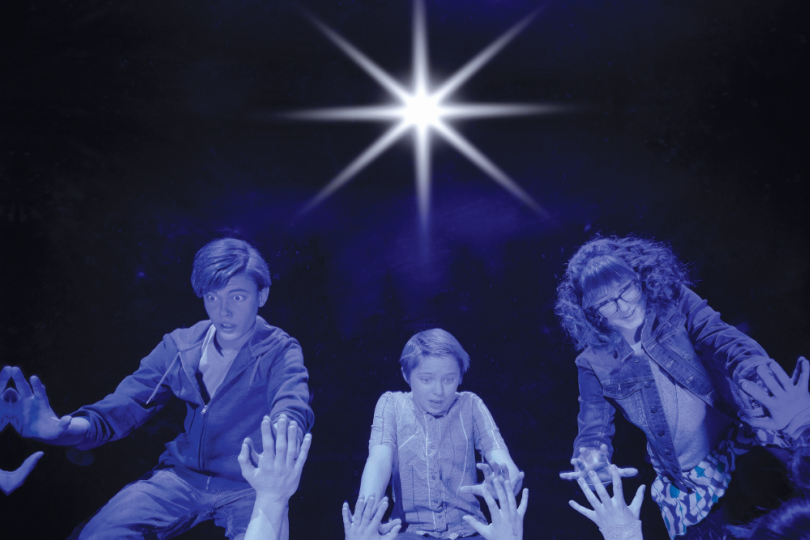A Stitch in Time Saves 3

To say that A Wrinkle in Time had, and continues to have, an enormous impact on Young Adult novels and the media spawned by them is an understatement. A Wrinkle in Time’s clever fusion of science-fiction, fantasy, and dystopian themes continue to resonate with audiences. Its protagonist, the fiery Meg Murry (Rachael Wasson), learns about the power of Love and the problems with conformity, eventually recognizing her stubbornness and quick emotions as sources of strength. Along for the ride are her little brother Charles Wallace (Valerie Heideman) and Calvin (Jaron Magstadt). John Glore’s play feels like a transcription of Madeleine L’Engle’s novel, with all its joy and fierce oddness.
Magical?
A very observant friend of mine recently had two small children. He is a board game enthusiast, and hopes to share this passion with his children. Thus, when you ask him what he is up to many evenings, he will tell you he is playing Uno. Not because he wants to play Uno, but because some day he wants to play Risk and Bridge and Settlers of Catan with his children, and the only way to do this is to play Uno with them now. They have to learn how to play games, the pleasure of playing with other people, and the beauty of using rules to achieve different ends. By the same token, we need productions aimed at younger audiences to help create a love of theatre. There are many charming and magical moments in Lyric Arts’ staging that will undoubtedly achieve this end. All around me, children were laughing, pointing, and whispering to their parents. In the final analysis, their enjoyment of the production matters the most, because the adults were all there to play Uno with them (and perhaps re-experience a favorite novel).
Lolly Foy’s physically comedic Mrs. Whatsit had the children around me laughing uproariously. The best moment of costuming/staging happens when she transforms into a beautiful winged beast. Standing on the central raised platform, large sparkly panels of fabric stretch from each upmost corner of the stage to wrap around her body, creating a dazzling expanse of wings. This made it feel not only like she transformed but had grown much larger and was filling the full stage. It is a lovely and relatively low-fi way to interpret the scene from the book. The surrounding children also loved the puppet design of Aunt Beast, although for me the realism of the puppet felt at odds with the rest of the toned-down stage elements.
The tension between the realism of Aunt Beast and the rest of the spare production highlights my central critique of the production. The trouble is that they didn’t fully commit to the high-production, fantastical elements of the story, but also didn’t commit to asking the audience to use their imagination. The identical children bouncing their identical balls (the first sign that something is truly wrong with Camazotz), are represented by a sound effect, but all the screens light up and flash, with sound effects galore, every time they tesser (teleport) across the galaxy. The central feature of the stage is a raised circular platform. One half of this platform’s perimeter is a staircase, and the other half is a black curtain. While the platform spins a lot during the performance to denote scene changes and moving action, it doesn’t feel spectacular enough for all the commotion. Additionally, there are constellations of small, square projection screens that framed the stage. To my mind, there was exactly the wrong amount of projections in this staging. The screens functioned as fragmented backdrops (think David Hockney), but never managed to shake a deeply utilitarian vibe.
Doing this play after THAT movie
2018 also saw a movie adaptation of A Wrinkle in Time. As reported by the Hollywood Reporter, it barely broke even with its 100 million dollar budget, earning 33.3 million its opening weekend. While reviewers cited many reasons for the movie’s underperformance, Richard Brody at The New Yorker summed up my feeling by pinpointing a lack within the movie’s script:
“...the script (by Jennifer Lee and Jeff Stockwell) dulls the sharpest details and eliminates the most idiosyncratic aspects of the novel, including most of the fascinatingly intricate world-building; what remains is a story that delivers emotional moments and delightful details that only vaguely cohere.” (Ava DuVernay’s “A Wrinkle in Time” Reviewed,” The New Yorker, March 7, 2018)
John Glore’s play does not fall into that trap, nor does Lyric Art’s staging, to their benefit. Having very recently reread the book, I can attest that the play is almost a transcription of the novel, and doesn’t shy away from its more overtly religious themes and perplexing dialogue. (Which to some extent makes sense -- this novel was written over 50 years ago. Further, Charles Wallace is self-proclaimed to be a bit strange, and he has quite a bit of dialogue.) I think that the actors did a good job with the script, particularly Wasson, Heideman, and Magstadt. They break through some of the more stilted sections to really connect with the audience. The adults have a harder time, but that is to be expected. L’Engle’s novel isn’t as concerned with the adults and their thoughts-- at its heart, A Wrinkle in Time is about Meg’s relationship to herself and the other children, so it makes sense that cutting through some of the more obvious passages would be difficult for the adult actors.
While I appreciate this production’s commitment to the strange dialogue and themes of the book, I ultimately felt as though I was playing Uno. The play is too stilted to be entirely memorable, but the children around me laughed and pointed and gasped, and in the end that is the point. So if you have children in your life you would like to introduce to non-screenbound science fiction and fantasy, and who would enjoy some clever live effects, go see A Wrinkle in Time at Lyric Arts in Anoka. On until May 20




